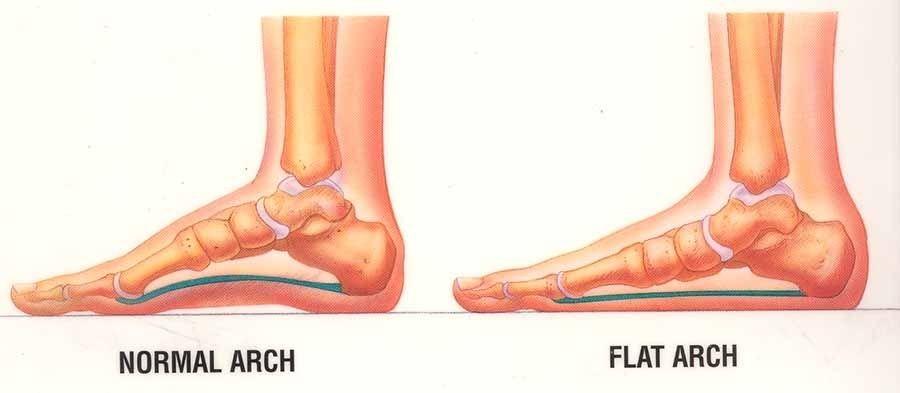Flat feet are characterized by a a flattening the the medial longitudinal arch (inside foot arch). This causes the foot to roll in excessively in order for the boy to maintain stability. This excessive internal rotation occurs at the subtaler joint in the ankle and is known as over pronation.
The image below shows a patient with a severe flat foot deformity with associated over pronation.
Causes
Flat feet can occur in all age groups but tends to be common in individuals that do little or no physical activity and gain weight which disturbs normal foot Biomechanics and leads to flat feet.
Flat feet can also be a congenital condition (you are born with flat feet) or can be as a result of either walking or running on hard surfaces. This repetitive micro trauma causes weakening of the posterior tibial tendon - PTT which hold the arch in position.
The PTT may also be damaged by specific conditions that can cause the condition such as:
- Fractures and trauma (e.g. transection of the tendon)
- Dislocation of the mid-foot bones
- Neuropathy leading to painless disorganization of the bones (e.g. Charcot joint in diabetic neuropathy)
- Arthritis affecting the relevant foot joints (e.g. in rheumatoid arthritis)
- Obesity
- Pregnancy
Symptoms
- Aching feet when standing, along the foot's medial border and medial aspect of the ankle
- Swelling of the midfoot on standing
- Visible deformity of the foot on standing with the medial border of the foot being tipped towards the floor
- The patient may be limping due to the loss of 'push-off' strength of the foot
- Patient notes that they walk on the inside of their foot and quickly wear out or squash the medial aspect of the soles of their shoes
- Advanced cases may note pain in the lateral ankle due to increased pressure between the calcaneus and fibula
Signs
- Look at shoes for evidence of excessive wear/squashing of mid sole along the inside border of the heel and midfoot
- A [podiatrist may assess arch height
- The arch will be lowered and the forefoot abducted
- A podiatrist may look at the foot from behind to seek evidence of your heels rolling out which will signify over pronation.
- You may be asked the to stand on tiptoes on the affected foot alone (holding on to something solid for support) with flat feet the PTT will not allow the heel to twist in and may cause pain, difficulty in completing the task, or a complete inability to perform a single heel-raise.
- Swelling and fluid in the tendon sheath along the course of the PTT may be noted when examining the foot with the patient seated and foot above the floor.
Further Problems
It is vitally important that treatment for flat feet is sought as this condition can cause a whole host of foot, leg, pelvic and back conditions. Problems such as:
- Corns and Calluses
- Plantar Fasciitis (heel pain)
- Patello-Femoral pain (knee pain)
- Achilles Tendonitis (ankle pain)
- Morton's Neuroma (swollen trapped nerve)
- Hallux Abducto Valgus (bunions)
- Metatarsalgia (ball of the foot pain)
- Shin pain
- Lumbo-Sacral Pain (lower back pain)
- Aching legs
Prevention & Treatment Options
Pes Planus can be effectively treated with orthotics (special insoles) that provide biomechanical support and help feet to function more efficiently. The most effective orthotics are those which are custom made to fit your foot, but in many cases a non-prescription orthotics or insoles can be used.
The orthotic should provide arch support to combat over pronation. Orthotics should be combined with supportive footwear that fits the foot correctly and contains a firm, low heel.

